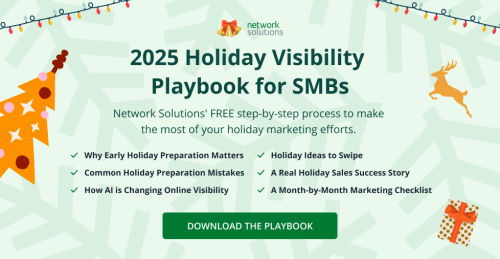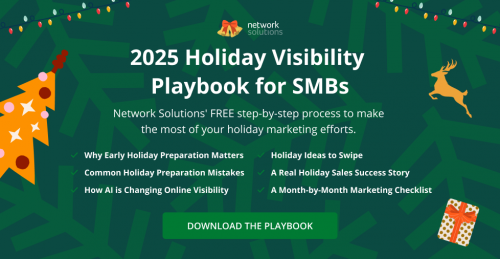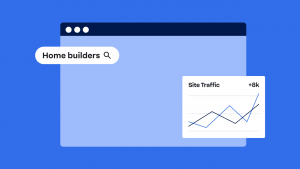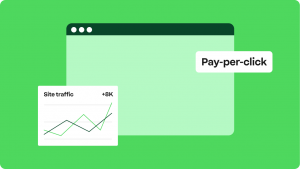Key takeaways:
- Getting your business ready for the holidays lets you adjust your strategy before the busy season arrives.
- Create a promotional calendar and update your website with seasonal content to capture a wider holiday audience.
- Connect with customers and boost sales by planning your blog and social content ahead of time.
Preparing for the holidays can make or break your seasonal sales. Shoppers are actively looking for gift ideas and great deals, and businesses that are ready to meet that demand will succeed. Be one of those businesses that captures the attention of early shoppers.
We interviewed Alicia Pringle, Senior Director of Network Solutions’ Online Marketing Team, to create an actionable holiday marketing checklist for SMBs to follow.
We’re here to help you navigate the holiday rush with confidence.
The 5 key steps for small business holiday prep in September
When should businesses start preparing for the holidays?
According to Alicia, “Customers are starting to think about researching gifts in September.” That makes September the perfect time to start your holiday preparations.
During this stage, the focus is on planning your campaigns, content, and promotions ahead of time. This helps you build momentum and carry out a marketing strategy that resonates with your customers.
Use the holiday marketing calendar checklist below to prepare your business for the upcoming rush:
- Finalize your holiday products, bundles, or services
- Create a promotional calendar with dates and offers
- Take holiday-themed product photos
- Update your website copy with seasonal keywords
- Start blog and social content planning
>> Want more Holiday Marketing tips? Check out our guide to holiday visibility planning.
Task 1. Finalize your holiday products, bundles, or services
Prepare your holiday offerings well in advance to make sure you have a steady supply of your most popular items. This way, you can cater to customer demand without the stress of last-minute sourcing.
You’ll also have time to develop appealing limited-edition bundles and seasonal services to capture holiday shoppers. Here’s how to finalize your holiday offerings:
Step 1. Identify best-selling products and adapt them for holiday demand
Start analyzing your past sales data to pinpoint your best-selling products. You can adapt these popular items for the holiday season by offering them in festive packaging or by combining them with other items to create enticing gift sets.
Build on what your customers already love but provide them with something new and special for the holidays.
Step 2. Create limited-edition holiday bundles or seasonal service packages
Make limited-time offerings to create a sense of urgency for shoppers. 31% of customers indicated limited-time sales and promotions influenced them to make a purchase, according to a 2023 study by the National Retail Federation.
For example, a coffee shop owner can offer a “Santa’s Secret” drink sold only from Thanksgiving to Christmas. The limited availability of the drink encourages customers to try it before it’s gone.
You can generate excitement for consumers and even test out new products during this time.
If you’re a service-based business, you can come up with unique service packages that set you apart from competitors. In her interview, Alicia shared a real-life example of an auto shop business that offered a clever holiday service package.
She recounted that “they did a really unique holiday promo where they packaged up a year of routine car maintenance. And they promoted it as a perfect gift for your college students or for those summer road trips that families might be doing, and it was just done in such a creative way.”
Focus on how you can provide more value to your customers during the holidays as you finalize your offerings.
Step 3. Offer special pricing strategies or incentives for gift buyers
Offer a small discount on bundles to encourage shoppers to buy more. For example, a small business selling homemade candles and soaps can create a discounted gift set of holiday-themed items.
They can sell the bundle for $30 instead of selling each product separately for a total cost of $35. This can motivate a customer to purchase the entire set rather than just one item.
You can also add a complimentary gift when they buy products or purchase a service.
Let’s say you’re a handmade jewelry artist. You can include a small polishing cloth or a pair of earrings with every necklace purchased.
If you’re a pet groomer, you can include a free festive bandana for their pets with their holiday grooming package.
Increase your products’ perceived value with these small additions and make them more appealing to gift buyers.
Task 2. Create a promotional calendar with dates and offers
Enhance your holiday season marketing by planning out all your marketing activities ahead of time. Use a promotional calendar to stay organized during the holiday rush.
Here’s how you can create a holiday promotional calendar:
Step 1. Map out key shopping dates and holidays
Prioritize major dates when holiday shoppers are most active, such as:
- Black Friday
- Cyber Monday
- Christmas Day
You can develop a solid framework for your promotional strategy by mapping these dates first.
Step 2. Assign specific promotions to each date
Think about what offer works best for each date. Plan a storewide discount for a high-traffic day like Black Friday. For a slower day, you can offer a free gift with a purchase.
Just be sure that each promotion serves a specific purpose, whether it’s attracting new customers or rewarding loyal ones.
Step 3. Align promotions with inventory and fulfillment capacity
Check your stock levels to confirm you can meet demand on the dates you set. If you’re planning a special bundle, be sure you have enough of each item to create all the sets you expect to sell.
This way, you can manage logistics efficiently and provide a smooth shopping experience for your customers.
It pays to plan ahead to avoid rushing and making mistakes. Get our free holiday marketing playbook to know more about the most common preparation mistakes to avoid this season.
Task 3. Take holiday-themed product photos and videos
Use holiday-themed photos to make your products more memorable during the festive season. Connect with shoppers on a personal level to stir feelings of joy, warmth, and nostalgia.
Leverage emotional connection to build true loyalty. 34% of consumers with deeper connections with brands tend to keep doing business with them, according to a 2024 survey by Emarsys.
Use these ideas for your holiday photoshoot:
Step 1. Use holiday props, colors, and lighting
Add a festive feel by using props, like:
- Wrapped presents
- Garlands
- Ornaments
Alicia recommends using a background with some red or blue, twinkly lights when taking the photos. “A little personalization helps get people in the holiday spirit,” she adds.
You can also experiment with warm, soft lighting to create a cozy and inviting mood. Make your products appear more enticing and help customers envision them in a festive setting.
Step 2. Make sure images are high-resolution and optimized properly
High-quality images can help customers see the details of your products. The pictures’ professional look and feel can build confidence among consumers. At the same time, compress these images so they load quickly on your website.
If pages take too long to load, visitors may leave before completing a purchase. In fact, 55% of shoppers abandon transactions after a poor online experience, according to a 2025 report by Conviva.
Find a balance between a high-resolution image and a fast-loading page to provide a smooth user experience.
For more insights on creating a positive consumer experience, check out our articles about improving website speed and finding out why customers abandon their carts.
Step 3. Create short holiday product videos for your socials
Short-form videos help you showcase your products in a more dynamic way. Videos provide a complete look, which adds another element to your holiday marketing efforts.
You can shoot an unboxing video where the person uses the item in a festive setting. You can also create explainer videos where you dig deeper into your product’s features.
This format can be particularly effective on platforms, such as:
- Instagram Reels
- TikTok
- YouTube Shorts
Task 4. Update your website copy with seasonal keywords
Start including seasonal keywords in your website copy in September to improve your visibility during the holidays. Search engine optimization (SEO) tactics can take some time to build momentum.
Incorporate terms that people are actively searching for so search engines recognize your content as relevant.
Here’s how you can update your copy:
Step 1. Research holiday-specific keywords related to your products or services
“Your customers are probably not going to think exactly like you as a business owner. So, try to think ‘what would they be searching for to find you,’ and then put those phrases or those questions right in your website copy,” advises Alicia.
You can also use free keyword research tools like Semrush, or look at Google Trends to discover popular search terms.
For example, if you own a bakery, you can use keywords like “Christmas cookies” or “holiday gift baskets.”
If you sell clothes online, use “matching family Christmas pajamas” or “New Year’s Eve party dresses,” if they align with your products.
Step 2. Refresh product descriptions, headlines, and CTAs with holiday keywords
Integrate the keywords naturally into your copy. For a headline, you can change “Custom Blankets” to “Cozy Holiday Gift Blankets.” In a product description, you can mention that an item is a “perfect gift for Mom.”
Create a cohesive holiday shopping experience by using this festive language throughout your site. Make your products feel more special and help customers see them as ideal presents.
Step 3. Update meta titles and descriptions for seasonal SEO
Your site’s meta title and meta description are the first set of information your audience sees when they search for holiday items. Meta titles are the blue links on a search results page, while meta descriptions are the brief page summaries underneath them.
Include a seasonal keyword and a compelling holiday message to entice people to click. If you sell Christmas decorations, for instance, you can use a meta title that reads “Holiday Ornaments & Decor | Shop Now.”
For the meta description, you can write, “Find unique holiday ornaments and festive decor to brighten your home this season. Free shipping on all orders!”
Download our free holiday marketing playbook for more tips on preparing your website for the holidays. We’ve included high-impact actions you can do despite your busy schedule.
Task 5. Start blog and social content planning
Plan your blog and social content ahead to develop a strategy that keeps you visible during the holiday season. Align your content with important dates, like Thanksgiving Day or Christmas Day, to stay at the top of customers’ minds.
Start planning your blog and social posts with these tips:
Step 1. Outline holiday-themed blog topics
Think about talking points related to the holidays to engage your readers. You can write gift guides to help shoppers find the perfect present. Try topics like “Top 10 Gifts for the Home Chef” or “Unique Stocking Stuffers Under $25.”
You can also offer holiday tips, such as “How to Prep a Holiday Party Without the Stress” or “Tips for Decorating on a Budget.” Use your content to provide value to your readers and to promote your products.
If you want tips for creating effective content, check out our article about what good website content looks like.
Step 2. Create a content calendar for consistent posting
Use a content calendar to help you visualize your holiday marketing campaigns from start to finish. You can map out when each blog post goes live and when to share social media updates that support it.
Use tools like Google Calendar or Trello to avoid missing important dates. If you work with a team, a content calendar is an excellent tool for coordination.
Step 3. Plan platform-specific campaigns to maximize reach and engagement
Customize your message to each platform based on its strengths. Instagram is great for visually-focused content, such as product photos or reels.
Facebook works well for longer-form posts and community building. You can also use email marketing for exclusive holiday offers or your latest blog posts.
Build a holiday marketing calendar that sleighs the competition
Get a head start with a holiday marketing calendar to organize your tasks and stay on track. Early preparation leads to a smoother execution and helps you engage customers more effectively.
If you feel overwhelmed with your holiday preparations, let Network Solutions help. Supporting businesses since the early days of the web, we offer professional digital marketing services in areas like SEO and business directory listings.
Increase your sales this holiday season with Network Solutions.

Frequently asked questions
Start preparing your holiday marketing strategy several months before the holiday season begins. Many consumers begin their holiday shopping and research as early as August and September.
Beginning early provides enough time to create detailed plans, refine your content, and prepare your website for increased traffic.
One of the most effective ways to promote holiday bundles is by creating high-quality, festive visuals that showcase their value. Use eye-catching photos and videos on social platforms to highlight items included in each bundle.
You can also create a dedicated landing page on your website to feature your bundles. If you’re open to it, you can work with influencers who align with your brand to promote the bundles to a wider audience.
To make your holiday website stand out, incorporate festive design elements without making the site cluttered or slow. Add subtle touches like seasonal colors, a holiday-themed banner, or a few small, decorative graphics.
Be sure your website’s navigation is simple and that holiday-specific products or sales are easy to find. You can also update your website copy and meta descriptions with seasonal keywords to help shoppers find you






